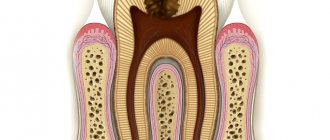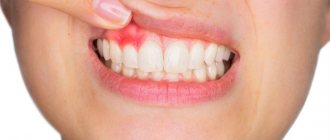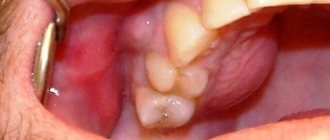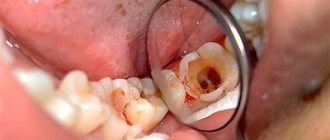Reasons for the formation of pus in the gums
There are several reasons for the formation of pus:
- The inflammatory process causes a disease such as periodontal disease (gingivitis).
- Periodontal disease.
- Mechanical damage to the gums.
- Chemical or thermal burn.
- Unprofessional removal of tartar, which affected the gums.
- Extensive caries causes pulpitis.
- Failure to comply with hygiene standards when performing dental procedures.
- Unsanitary oral cavity.
- Types 1 and 2 diabetes mellitus.
- Summing up the causes of purulent inflammation of the gums, we can highlight the main factor that causes this disease – the vital activity of pathogenic microorganisms.
What is a tooth abscess
An abscess in dentistry is an inflammatory process accompanied by the formation of a cavity with pus near a segment or its root. The abscess on the root of the tooth is surrounded by a dense connective tissue capsule, separating it from healthy tissue. Pyogenic bacteria penetrate into the unit through chips, cracks, and carious cavities.
During their life, microbes produce toxins that irritate the pulpal nerve receptors, which causes pain. In addition, toxic products of pathogenic flora increase vascular permeability, resulting in soft tissue swelling.
There are three main types of abscess:
- Periapical - pus accumulates at the root of the tooth (near its apex). A hilar abscess is formed due to an infectious lesion of the pulp. The etiological factor is untreated caries or periodontitis. The progressive inflammatory process spreads to the periosteum and surrounding soft tissue with the formation of a fistula and purulent lump on the gum.
- Periodontal - the focus is located inside the periodontal pockets. The cause is periodontitis. The pulp remains intact, and the infection is localized between the gum and the alveolar ridge.
- Desnevoy. Gum abscess is a purulent formation in the area of the gingival papillae between the segments.
Signs of pus and purulent inflammation
- severe pain in the area of the wisdom tooth; when you press on the gum, pus is released;
- redness of the gums and swelling;
- a large carious cavity is filled with softened soft tissue;
- colored plaque on the tooth and tartar;
- enlarged lymph nodes;
- change in facial contour. It becomes asymmetrical.
Tooth abscess: what is it - symptoms and treatment
A dental abscess is an acute infectious pathology characterized by a clearly limited accumulation of pus in the root area. The purulent process is often a dangerous complication of periodontitis, periostitis, and other dental diseases. The lack of timely treatment threatens with adverse consequences not only for the affected segment, but also for the entire body. In Moscow, dental services are provided by the Center for Aesthetic Dentistry near the Otradnoye metro station. Our doctors will quickly and efficiently help eliminate any problem with sore teeth and gums.
Treatment
Treatment is prescribed after a visual examination of the oral cavity and determination of the source of pus. Treatment of purulent inflammation can be:
- In a therapeutic way with the help of medicinal drugs.
- Physiotherapeutic.
- Surgery.
If purulent discharge does not stop after a course of therapeutic treatment, the doctor will prescribe surgery. Before the operation, plaque and tartar are cleaned and the mouth is disinfected.
An injection with a local anesthetic is injected into the gum and the gum is cut. The gum mucosa is cleaned of pus. If the fistula through which pus flowed is large, then a drainage is inserted. In the postoperative period, the patient is prescribed therapeutic treatment, which includes taking antibiotics and rinsing the mouth with a 0.05% chlorhexide solution, and is prescribed a complex of vitamins and minerals.
Every day, until complete healing, the patient must come to the dentist, where he is given an antibacterial application on the gum of the wisdom tooth. The patient must strictly follow all the dentist’s recommendations for oral care and consume only liquid foods.
Causes
The main causes of tooth abscess can be considered:
- various untreated oral diseases (for example, cyst, pulpitis, caries and others);
- injuries to the jaw or mouth that led to the breaking off or fracture of a tooth;
- infection (brought in by blood);
- damage to the skin around the mouth or mucous membranes;
- the appearance of boils (on the skin) near the jaw;
- the appearance of infection due to drift during injections;
- poor oral hygiene.
Any tooth in the oral cavity is susceptible to an abscess, but those teeth that are involved in chewing food, as well as wisdom teeth, are most susceptible. An abscess is often accompanied by infections in the respiratory tract.
Symptoms
Experts call the following symptoms that accompany an abscess:
- acute pain (can be aching or throbbing);
- toothache when chewing;
- greater sensitivity of the tooth when exposed to temperature;
- bitter taste in the mouth;
- change in appetite;
- general malaise;
- discomfort accompanying a person;
- enlarged cervical lymph nodes;
- elevated temperature;
- the gums become red;
- the appearance of open ulcers with pus on the gums;
- swelling of the face near the jaw.
After the tooth root has died, the symptoms (not all) may disappear, but this is a temporary effect, since the infection will still develop.
It is possible that the abscess may open on its own. This means the transition of an acute to a chronic abscess, after which the symptoms subside. Chronic abscess is fraught with other exacerbations with complications.
Complications
Chronic abscess is the most harmless complication. Occurs with varying frequency. Chronic abscess is difficult to treat and can lead to complications.
A purulent tooth abscess is dangerous due to complications; if left untreated, the following may occur:
- Phlegmon is a tumor that does not have clear boundaries. Cellulitis is dangerous because it can be fatal. Requires surgical treatment.
- Sepsis is blood poisoning. Against the background of an infectious process, septic shock may develop in the patient’s body.
- A cyst is a benign tumor that tends to grow. It is useless to treat it with medication; surgical intervention is required.
- Meningitis is an inflammation of the membranes of the brain that affects a person’s mental state, leading to blindness, deafness and other serious consequences.
- Brain abscess - occurs because pathogens enter the brain, causing inflammation. The complication is difficult to treat and can lead to the death of the patient.
Symptoms of gum abscess
The main symptom of the disease is pain. It has a different character (aching, pulsating, acute), is constant or occurs periodically under the influence of stress factors (cold, heat, sour, sweet foods). The pain is often worse when chewing. It can be local or spread to neighboring teeth, ears, eyes. In addition, with an abscess there are other clinical manifestations:
- hyperemia of soft tissues around the affected segment;
- swelling of the inflammation zone;
- bitter taste in the mouth;
- foul odor;
- mobility and change in the natural color of the segment;
- the presence of an ulcer on the gum with purulent discharge;
- enlargement of the submandibular lymph nodes;
- facial deformation due to swelling;
- hyperthermia, lethargy, sleep disturbance.
Symptoms of wisdom tooth inflammation
The primary and main symptoms are the appearance of swelling and soreness of the gums. What symptoms are characteristic of inflammation?
- Pain . Covers the side of the face where the tooth is located. Location: gums, jaw. If the tooth is on the upper jaw, acute pain can reach the temple and cheekbones. The pain goes away after the inflammation disappears.
- Swelling , burning sensation and pain when touched.
- Bad breath. It means that the inflamed area is festering.
The development of a purulent process, the formation of a cyst or periostitis is indicated by the acute nature of the pain, inflammation and pulsation of the gums, enlarged lymph nodes and difficulty swallowing. Also among the atypical symptoms are dizziness and low-grade body temperature (37-38 degrees).
How to relieve wisdom tooth gum inflammation
If there are symptoms of inflammation, treatment at home is impossible. If the pain is acute and causes discomfort, you are allowed to give yourself first aid. Such actions are justified only by the impossibility of urgently visiting the dentist (for example, if the pain is tormented late at night or on a weekend). But at the first opportunity, an examination by a specialist is required, the cause is identified and appropriate therapy is prescribed.
Chlorhexidine
Why does a tooth fester?
Let's look at why pus forms in teeth. The causes of the pathology can be:
- mechanical damage to the oral mucosa;
- dental diseases of an infectious nature (caries, pulpitis, periodontitis, periodontitis, gingivitis, etc.);
- hematogenous spread of microbes from other foci of infection in the body (sinusitis, pneumonia, pharyngitis, tonsillitis, adnexitis, etc.);
- maxillofacial injuries accompanied by a violation of the integrity of the segment;
- insufficient oral hygiene;
- Iatrogenic causes associated with the introduction of bacteria during dental treatment.
There are risk factors, the presence of which increases the likelihood of pathology: smoking, decreased body defenses, hypothermia, chronic stress. Timely treatment of tooth root periodontitis and other dental diseases reduces the likelihood of an abscess.
How to treat a tooth abscess
Treatment of a tooth abscess is aimed at eliminating the infectious process and relieving pain. A comprehensive program may include the following activities:
- Opening and draining the lesion. An incision is made on the gum, a drainage is installed through which the pus can freely come out. The drainage system is installed for several days. During this period, the patient is prescribed rinses with antiseptics and saline solutions.
- Endodontic treatment. It involves removing the pulp, treating the root canals with medications and filling them.
- Excision of the root apex. Surgical intervention is performed when the source of infection is located in the periapical area. The surgeon cuts the gum and removes the abscess along with the affected part of the root. The segment itself is preserved.
- Removing a unit. The need for tooth extraction occurs when there is significant destruction of the tooth.
- Therapy with broad-spectrum antibiotics.
- Restoration of the coronal part with a filling or orthopedic construction.
General information about wisdom teeth
Other names are third molars or eights. Each person has 2 rudiments in the upper and lower jaw, but not all can grow. Often wisdom teeth do not erupt and remain covered by bone or tissue (impacted teeth) or partially grow in (semi-impacted teeth). The typical time period for growth of eights is 14-30 years.
Third molars do not have primary teeth as predecessors. Often, during the eruption of figure eights, all the free space in the jaw is already occupied - the tooth grows into the cheek, into the adjacent tooth, into the oral cavity. The third molars close the row of teeth, they are located inconveniently, and it is difficult to clean them. These features cause various pathologies and complications during eruption or after removal.
Eights have a histological difference from other teeth. The roots of wisdom teeth are irregularly shaped (crooked or underdeveloped). This complicates the growth and subsequent treatment of the tooth. Dentin and enamel are characterized by weak resistance to carious lesions.











